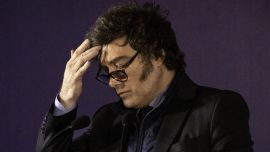Asif Kapadia initially passed when, in 2012, producer Paul Martin approached him about making a documentary on Diego Maradona.
Kapadia had just finished Senna, his groundbreaking 2010 documentary on the late Brazilian Formula One racer Ayrton Senna. He didn’t want to do another sports doc, especially about another South American sports hero. Instead, he went off and made Amy, the intimate Amy Winehouse that reappraised the British soul singer as a victim of her own success. It won Kapadia the Oscar for Best Documentary.
But Kapadia couldn’t shake off the project or the appeal of combing through Maradona’s personal archives, including more than 500 hours of neverbefore-seen footage. Kapadia this week premiered the result, Diego Maradona, at the Cannes Film Festival, where Amy also made its début.
In Maradona, the British filmmaker found a combination of his first two subjects, both of whom died tragically young.
“He starts up almost like Senna, but he ends up more like Amy. He’s a bit of both, but different, because he gets older,” Kapadia said at a beachside restaurant in Cannes. “In a way, the empathy is different. It’s a like more mature relationship with him. I fell in love with Senna and Amy, in a way. But they were easier because they were younger.”
Kapadia hasn’t yet been able to screen the film for Maradona. The Argentine footballing icon withdrew from attending the film’s Cannes premiere because of a shoulder injury, according to a statement. HBO acquired the documentary ahead of Cannes, with plans to air it September 24 after an Oscar-qualifying run.
Diego Maradona, like Senna and Amy, has the propulsion and visual drive of a fiction movie. It’s Kapadia’s most mythically drawn film, zeroing in on Maradona’s time with the Italian club Napoli, starting with his arrival on July 5, 1984.
T h e n t h e world’s greatest player, the frenzy surrounding him — an almost primal hero worship — grows even more extreme when he turns the flailing club into champions. Maradona becomes a g o d , o n l y to lat e r leave Italy trail e d b y scand a l a n d drug addiction. In the eyes of Italians betrayed by the Albiceleste’s 1990 World Cup defeat of Italy, he turns into the devil. Asif Kapadia’s documentary captures Maradona’s rise and fall
And just like Senna and Amy, there are no talking heads anywhere.
‘IT’S ABOUT DIEGO’
“If you’re making a documentary, the minute I cut to a talking head, you become aware of me,” says Kapadia. “A lot of people have no idea who made Senna or who made Amy. I’m cool with that. I don’t want to be in the film. It’s not about me. It’s not my opinion. It’s not my journey of making the film. It’s about him. It’s about her. It’s about Diego.”
Kapadia certainly didn’t invent the archival-based documentary, but he has greatly popularised it. His influence can be seen on a recent wave of docs, including Apollo 11 and Peter Jackson’s They Will Not Grow Old. Kapadia doesn’t make any such claims, but grants: “I can see that there is before Senna and after Senna.”
The footage in Diego Maradonacomes from the late Jorge Cyterszpiler, a friend and agent to Maradona. He hired two cameramen to follow Maradona in the early 1980s, covering his time in Naples.
Audio of extensive interviews conducted by Kapadia is heard throughout Diego Maradona, including with Maradona. He was predictably difficult to get a hold of. “People would say, ‘He might be fine tomorrow'.
by BY JAKE COYLE





















Comments